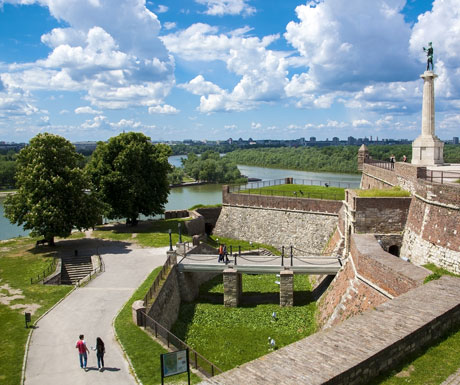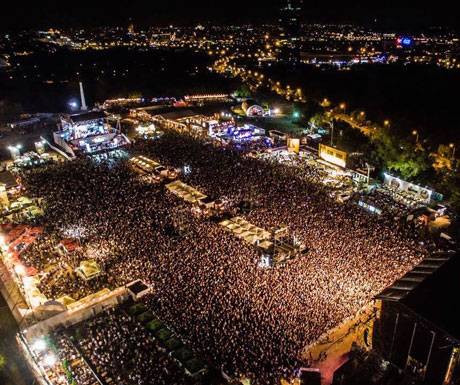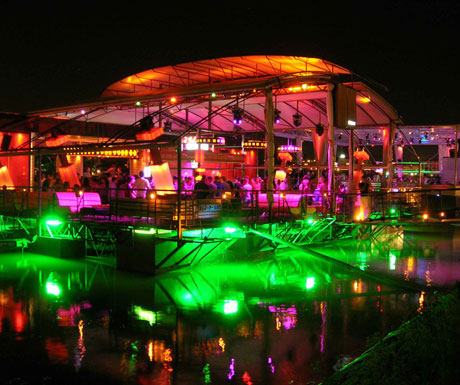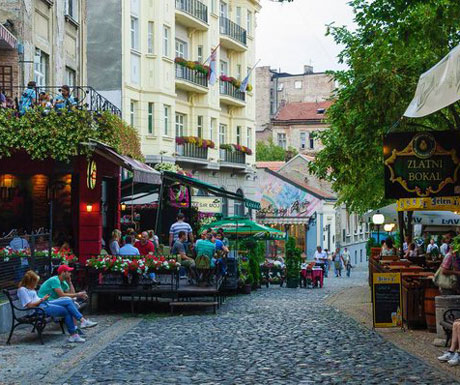Attractions · Eastern Europe · Europe · Events · Going Out · Leisure Travel · Regions · Serbia and Montenegro · Speciality Travel · Travel Miscellany
4 great reasons to visit Belgrade
One of Europes best kept secrets, Belgrade should be on every adventurous travellers radar. Out of the ashes of communism, Belgrade has emerged as a leading cultural European city, with plenty of urban charm. Heres why Serbias capital should be next on your must-experience list.
The history
The indelible mark of Belgrades turbulent history is strewn across the city, from success to failure, kingdom to revolution, bombing to democracy; it seems almost nothing has bypassed this most defiant of ancient cities, and yet it has managed to keep its unique soul.
 The capitals vibrancy sits alongside its numerous historical sites, such as the Kalemegdan Fortress. Constructed during the invasion by the Roman Empire, this impressive 1st century fortification, located at the tip of the peninsula where the Daunbe and Sava rivers meet, was a highly strategic and important military base in medieval Europe. Today, it is one of the most charming free-to-roam parks in the world, with over 53 hectares of romantic green space and a museum presenting the complete military history of the former Yugoslavia. Even The Turks recognised its beauty, naming it “Contemplation Hill”.
The festivals
Belgrade hosts around 100 diverse festivals, most of which are international in character. The most well-established festivals include Belgrade Jazz Festival and Belgrades Beer Festival.
The capitals vibrancy sits alongside its numerous historical sites, such as the Kalemegdan Fortress. Constructed during the invasion by the Roman Empire, this impressive 1st century fortification, located at the tip of the peninsula where the Daunbe and Sava rivers meet, was a highly strategic and important military base in medieval Europe. Today, it is one of the most charming free-to-roam parks in the world, with over 53 hectares of romantic green space and a museum presenting the complete military history of the former Yugoslavia. Even The Turks recognised its beauty, naming it “Contemplation Hill”.
The festivals
Belgrade hosts around 100 diverse festivals, most of which are international in character. The most well-established festivals include Belgrade Jazz Festival and Belgrades Beer Festival.
 Founded in 1971, the Belgrade Jazz Festival is Serbias oldest music festival and enjoys the highest acclaim when it comes to the international jazz scene. The festival aims to showcase the achievement of the finest artists in global jazz, and acts as the meeting point of West and East, North and South. This year (October 28 to November 1 2016), the festival is promoting the future of musical arts, featuring a swag of rising talent in jazz from around the world, alongside the most popular names in jazz.
Visiting in summer? Belgrades Beer Festival (August 17 to 21 2016) showcases hundreds of domestic and foreign beers. Considered one of Europes biggest summer parties, over 500,000 visitors are drawn here annually. Whats more, admission to the festival is free.
The nightlife
Named as one of the top 10 cities for its nightlife by National Geographic, Belgrade is famous for its exciting nightlife and has a diverse winter/summer offering. During winter, a whole host of clubs are open in the inner city, particularly Savamala and Dorcol; the first is Belgrades newest arty hangout, the second is the citys go-to for the young and fun. Clubbing here is a surreal experience for Western travellers of the super-club-generation. Alongside legendary house and techno club The Tube, in Dorćol, sits some spectacularly edgy venues such as Mr Stefan Braun; located on the ninth floor of an abandoned office block in Savamala.
Founded in 1971, the Belgrade Jazz Festival is Serbias oldest music festival and enjoys the highest acclaim when it comes to the international jazz scene. The festival aims to showcase the achievement of the finest artists in global jazz, and acts as the meeting point of West and East, North and South. This year (October 28 to November 1 2016), the festival is promoting the future of musical arts, featuring a swag of rising talent in jazz from around the world, alongside the most popular names in jazz.
Visiting in summer? Belgrades Beer Festival (August 17 to 21 2016) showcases hundreds of domestic and foreign beers. Considered one of Europes biggest summer parties, over 500,000 visitors are drawn here annually. Whats more, admission to the festival is free.
The nightlife
Named as one of the top 10 cities for its nightlife by National Geographic, Belgrade is famous for its exciting nightlife and has a diverse winter/summer offering. During winter, a whole host of clubs are open in the inner city, particularly Savamala and Dorcol; the first is Belgrades newest arty hangout, the second is the citys go-to for the young and fun. Clubbing here is a surreal experience for Western travellers of the super-club-generation. Alongside legendary house and techno club The Tube, in Dorćol, sits some spectacularly edgy venues such as Mr Stefan Braun; located on the ninth floor of an abandoned office block in Savamala.
 It is during summer, though, when the city truly comes to life. Spread along the along the banks of the Sava and Danube Rivers, the glittering expanse of the floating river clubs or barges (called “splavs” or “splavovi”) are the most recognizable feature of summer in Belgrade. In cool, ephemeral fashion, many splavovi permanently close each summer (re-opening as a completely new club the following year) but some like 20/44 provide the ultimate year-round, all-weather party.
The culture
Skadarlija is a historic street, in an urban neighbourhood in the downtown area of Belgrade, and forms part of what is considered the main bohemian quarter of Belgrade. Original settlers of this beautiful part of Belgrade were Gypsies in the 1830s. The area began acquiring its bohemian character in the last few decades of the 19th century, owing to the proximity of the National Theatre and the closure of cult café, the Dardanelli Inn, which led the flourishing community of writers, poets, actors and painters to seek out new haunts along the street.
It is during summer, though, when the city truly comes to life. Spread along the along the banks of the Sava and Danube Rivers, the glittering expanse of the floating river clubs or barges (called “splavs” or “splavovi”) are the most recognizable feature of summer in Belgrade. In cool, ephemeral fashion, many splavovi permanently close each summer (re-opening as a completely new club the following year) but some like 20/44 provide the ultimate year-round, all-weather party.
The culture
Skadarlija is a historic street, in an urban neighbourhood in the downtown area of Belgrade, and forms part of what is considered the main bohemian quarter of Belgrade. Original settlers of this beautiful part of Belgrade were Gypsies in the 1830s. The area began acquiring its bohemian character in the last few decades of the 19th century, owing to the proximity of the National Theatre and the closure of cult café, the Dardanelli Inn, which led the flourishing community of writers, poets, actors and painters to seek out new haunts along the street.
 Since then, this wide cobbled alleyway has become home to a medley of artisanal craftsman, art galleries and traditional restaurants serving national Serbian cuisine, most notably rotilj (grilled meat) with pivo (beer); eir moj is among the most famous of Serbian restaurants, with its potted-plant exterior.
Savamala, formerly the citys harbour and dockside trading hub, with a reputation to match, is now perhaps Belgrades most dynamic and artistic district. Dubbed the Creative District, it is enriched with murals, street art, clubs, creative industries and art galleries. The re-vitalization of the area was confirmed with the opening of the industrial warehouse-turned-cultural-space, KC Grad, and Miksers, which hosts a restaurant and the Balkan Design Store – where you can find works by extremely talented designers.
Jack Huang is CEO of Truly Experiences.
If you would like to be a guest blogger on A Luxury Travel Blog in order to raise your profile, please contact us.
Since then, this wide cobbled alleyway has become home to a medley of artisanal craftsman, art galleries and traditional restaurants serving national Serbian cuisine, most notably rotilj (grilled meat) with pivo (beer); eir moj is among the most famous of Serbian restaurants, with its potted-plant exterior.
Savamala, formerly the citys harbour and dockside trading hub, with a reputation to match, is now perhaps Belgrades most dynamic and artistic district. Dubbed the Creative District, it is enriched with murals, street art, clubs, creative industries and art galleries. The re-vitalization of the area was confirmed with the opening of the industrial warehouse-turned-cultural-space, KC Grad, and Miksers, which hosts a restaurant and the Balkan Design Store – where you can find works by extremely talented designers.
Jack Huang is CEO of Truly Experiences.
If you would like to be a guest blogger on A Luxury Travel Blog in order to raise your profile, please contact us.
 The capitals vibrancy sits alongside its numerous historical sites, such as the Kalemegdan Fortress. Constructed during the invasion by the Roman Empire, this impressive 1st century fortification, located at the tip of the peninsula where the Daunbe and Sava rivers meet, was a highly strategic and important military base in medieval Europe. Today, it is one of the most charming free-to-roam parks in the world, with over 53 hectares of romantic green space and a museum presenting the complete military history of the former Yugoslavia. Even The Turks recognised its beauty, naming it “Contemplation Hill”.
The festivals
Belgrade hosts around 100 diverse festivals, most of which are international in character. The most well-established festivals include Belgrade Jazz Festival and Belgrades Beer Festival.
The capitals vibrancy sits alongside its numerous historical sites, such as the Kalemegdan Fortress. Constructed during the invasion by the Roman Empire, this impressive 1st century fortification, located at the tip of the peninsula where the Daunbe and Sava rivers meet, was a highly strategic and important military base in medieval Europe. Today, it is one of the most charming free-to-roam parks in the world, with over 53 hectares of romantic green space and a museum presenting the complete military history of the former Yugoslavia. Even The Turks recognised its beauty, naming it “Contemplation Hill”.
The festivals
Belgrade hosts around 100 diverse festivals, most of which are international in character. The most well-established festivals include Belgrade Jazz Festival and Belgrades Beer Festival.
 Founded in 1971, the Belgrade Jazz Festival is Serbias oldest music festival and enjoys the highest acclaim when it comes to the international jazz scene. The festival aims to showcase the achievement of the finest artists in global jazz, and acts as the meeting point of West and East, North and South. This year (October 28 to November 1 2016), the festival is promoting the future of musical arts, featuring a swag of rising talent in jazz from around the world, alongside the most popular names in jazz.
Visiting in summer? Belgrades Beer Festival (August 17 to 21 2016) showcases hundreds of domestic and foreign beers. Considered one of Europes biggest summer parties, over 500,000 visitors are drawn here annually. Whats more, admission to the festival is free.
The nightlife
Named as one of the top 10 cities for its nightlife by National Geographic, Belgrade is famous for its exciting nightlife and has a diverse winter/summer offering. During winter, a whole host of clubs are open in the inner city, particularly Savamala and Dorcol; the first is Belgrades newest arty hangout, the second is the citys go-to for the young and fun. Clubbing here is a surreal experience for Western travellers of the super-club-generation. Alongside legendary house and techno club The Tube, in Dorćol, sits some spectacularly edgy venues such as Mr Stefan Braun; located on the ninth floor of an abandoned office block in Savamala.
Founded in 1971, the Belgrade Jazz Festival is Serbias oldest music festival and enjoys the highest acclaim when it comes to the international jazz scene. The festival aims to showcase the achievement of the finest artists in global jazz, and acts as the meeting point of West and East, North and South. This year (October 28 to November 1 2016), the festival is promoting the future of musical arts, featuring a swag of rising talent in jazz from around the world, alongside the most popular names in jazz.
Visiting in summer? Belgrades Beer Festival (August 17 to 21 2016) showcases hundreds of domestic and foreign beers. Considered one of Europes biggest summer parties, over 500,000 visitors are drawn here annually. Whats more, admission to the festival is free.
The nightlife
Named as one of the top 10 cities for its nightlife by National Geographic, Belgrade is famous for its exciting nightlife and has a diverse winter/summer offering. During winter, a whole host of clubs are open in the inner city, particularly Savamala and Dorcol; the first is Belgrades newest arty hangout, the second is the citys go-to for the young and fun. Clubbing here is a surreal experience for Western travellers of the super-club-generation. Alongside legendary house and techno club The Tube, in Dorćol, sits some spectacularly edgy venues such as Mr Stefan Braun; located on the ninth floor of an abandoned office block in Savamala.
 It is during summer, though, when the city truly comes to life. Spread along the along the banks of the Sava and Danube Rivers, the glittering expanse of the floating river clubs or barges (called “splavs” or “splavovi”) are the most recognizable feature of summer in Belgrade. In cool, ephemeral fashion, many splavovi permanently close each summer (re-opening as a completely new club the following year) but some like 20/44 provide the ultimate year-round, all-weather party.
The culture
Skadarlija is a historic street, in an urban neighbourhood in the downtown area of Belgrade, and forms part of what is considered the main bohemian quarter of Belgrade. Original settlers of this beautiful part of Belgrade were Gypsies in the 1830s. The area began acquiring its bohemian character in the last few decades of the 19th century, owing to the proximity of the National Theatre and the closure of cult café, the Dardanelli Inn, which led the flourishing community of writers, poets, actors and painters to seek out new haunts along the street.
It is during summer, though, when the city truly comes to life. Spread along the along the banks of the Sava and Danube Rivers, the glittering expanse of the floating river clubs or barges (called “splavs” or “splavovi”) are the most recognizable feature of summer in Belgrade. In cool, ephemeral fashion, many splavovi permanently close each summer (re-opening as a completely new club the following year) but some like 20/44 provide the ultimate year-round, all-weather party.
The culture
Skadarlija is a historic street, in an urban neighbourhood in the downtown area of Belgrade, and forms part of what is considered the main bohemian quarter of Belgrade. Original settlers of this beautiful part of Belgrade were Gypsies in the 1830s. The area began acquiring its bohemian character in the last few decades of the 19th century, owing to the proximity of the National Theatre and the closure of cult café, the Dardanelli Inn, which led the flourishing community of writers, poets, actors and painters to seek out new haunts along the street.
 Since then, this wide cobbled alleyway has become home to a medley of artisanal craftsman, art galleries and traditional restaurants serving national Serbian cuisine, most notably rotilj (grilled meat) with pivo (beer); eir moj is among the most famous of Serbian restaurants, with its potted-plant exterior.
Savamala, formerly the citys harbour and dockside trading hub, with a reputation to match, is now perhaps Belgrades most dynamic and artistic district. Dubbed the Creative District, it is enriched with murals, street art, clubs, creative industries and art galleries. The re-vitalization of the area was confirmed with the opening of the industrial warehouse-turned-cultural-space, KC Grad, and Miksers, which hosts a restaurant and the Balkan Design Store – where you can find works by extremely talented designers.
Jack Huang is CEO of Truly Experiences.
If you would like to be a guest blogger on A Luxury Travel Blog in order to raise your profile, please contact us.
Since then, this wide cobbled alleyway has become home to a medley of artisanal craftsman, art galleries and traditional restaurants serving national Serbian cuisine, most notably rotilj (grilled meat) with pivo (beer); eir moj is among the most famous of Serbian restaurants, with its potted-plant exterior.
Savamala, formerly the citys harbour and dockside trading hub, with a reputation to match, is now perhaps Belgrades most dynamic and artistic district. Dubbed the Creative District, it is enriched with murals, street art, clubs, creative industries and art galleries. The re-vitalization of the area was confirmed with the opening of the industrial warehouse-turned-cultural-space, KC Grad, and Miksers, which hosts a restaurant and the Balkan Design Store – where you can find works by extremely talented designers.
Jack Huang is CEO of Truly Experiences.
If you would like to be a guest blogger on A Luxury Travel Blog in order to raise your profile, please contact us.Did you enjoy this article?
Receive similar content direct to your inbox.


Interesting post!!it looks like an amazing place and worth visiting..i’d like visit this place soon…
I just can’t believe that I haven’t heard more about Belgrade, I would have thought that it’s an ideal destination for a long weekend, probably not so heavy on the wallet as many other European cities. And it has both a beer festival and a jazz festival. What more could anyone want?
I must admit I’d never even considered Belgrade for a holiday, you don’t see it mentioned much in travel guides which is a shame. I knew there were a few festivals there but around 100? That’s more than I would have imagined! I love the sound of how rich the history and culture is, that’s what I’d be interested in above the nightlife personally. That said, I wouldn’t say no to free entry to the beer fest!